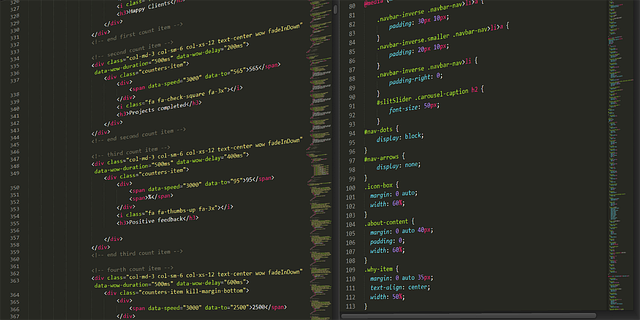How are software development and sustainability interconnected? What role do tech companies play in the fight against climate change? Can software development really contribute to a greener future? These are some of the thought-provoking questions surrounding the intriguing relationship between technology, software development, and environmental sustainability.
As pointed out by the World Economic Forum and the International Energy Agency, the fast-paced growth of the tech industry is inadvertently contributing to the planet’s carbon footprint. This raises a pressing issue: as we continue to expand and rely on technology, how can we ensure it doesn’t compromise our commitment to combating climate change? Understanding the magnitude of this problem, it’s crucial to consider viable solutions, particularly in the USA, a major contributor to global tech advancements.
In this article, you will gain insights into what some committed companies are already doing to propel sustainable software development. You will be introduced to initiatives promoting energy-efficient software design, the adoption of renewable energy for powering data centers, and green cloud-computing solutions.
This piece will also shed light on the significance of sustainability in the software industry, highlighting how green tech principles can be incorporated into the development process. Providing glimpses into the future of software development, it underlines the idea that sustainability and innovation can go hand in hand.
![]()
Definitions and Notions Behind Sustainable Software Development
Sustainable software development is a methodology that focuses on minimizing the environmental impact of creating, using and disposing of software. It is built on the principles of producing high-quality software that meets user needs, while having a minimal ecological footprint. This is achieved through strategies such as energy efficient programming, green cloud computing and ecologically sensitive disposal of hardware.
Green tech, on the other hand, is the use of technology for environmentally sustainable ends. This covers a wide range of applications, from renewable energy and electric transport to waste recycling and water purification. Many companies are now committed to implementing green tech in their operations, as they recognize both its environmental benefits and its potential for cost savings and innovation.
Unwrapping the Green Gift: Pioneers Promoting Sustainable Software Development
The Role of Tech Giants in Sustainability
Tech giants have a significant role to play in driving sustainability efforts within the industry. As leadership figures in the field, these companies set the tone for the overall sector, and thus hold significant power to effect meaningful change, particularly in respect to sustainable software development. For the purposes of this topic, sustainable software development is defined as the process of designing software that has minimal environmental impact during its lifecycle, including development, use, and disposal.
The influence of tech giants extends past the immediate software they create, as they also mold the practices of smaller companies and startups. Their commitment in launching and maintaining green initiatives is integral to not only redefining their responsibility towards the environment, but also shaping the future of the tech industry. By adopting green software development methodologies, these massive corporations can lead the way in reducing the overall industry’s carbon footprint.
Companies Embarking on Sustainable Software Development
Several notable companies have begun to make strides towards sustainable software development, though there is still much work to be done.
- Google, for example, has recently committed to using low-carbon materials in its product design and decarbonizing its global supply chain by 2022.
- Microsoft has set an ambitious goal of becoming carbon negative by 2030, which involves not only reducing and eliminating its carbon footprint, but also removing additional carbon from the environment.
- Amazon has introduced a Climate Pledge, committing to reach the Paris Agreement ten years early, and become net-zero carbon by 2040. This pledge involves multiple aspects of the company’s operations, not least of which is sustainable software development.
These initiatives taken by tech giants certainly herald a promising start. However, to truly embed sustainable software development within the industry, these companies need to ensure that their efforts are not one-off endeavours but are woven into their long-term strategic plans.
Despite the progress being made in sustainable software development, the tech industry still has a long way to go. For truly sustainable change to come into effect, a comprehensive shift in mindset is needed. This involves viewing sustainability not as an optional extra or PR boost, but as an essential and integral part of the software development process. As more tech giants acknowledge their environmental responsibilities and embed sustainable practices into their operations, the path towards an environmentally conscious tech industry becomes clearer.
Unearthing the Eco-Friendly Path: Strategies and Challenges of Sustainable Software Development
Reconsidering our Digital Footprint?
Is there any room left for greener alternatives in the information technology world, especially in development and coding? Absolutely. The scope of sustainability has expanded beyond physical manufacturing. There’s now a need to consider the carbon footprint of our electronic lives as we dive deeper into the information age. Data centers, cloud storage, digital marketing, and software development – all these sectors use energy, often generated from non-renewable sources, making them contributing elements to global carbon emissions. The issue primarily lies in the highly energy-demanding nature of these sectors and lack of recognition or strategies in place to mitigate their environmental impacts.
Recognizing and Tackling the Carbon-Heavy Software Industries
The digital realm, despite its perceived ephemeral nature, carries a solid weight-to-energy ratio. For instance, the global IT and data center sectors account for an estimated 2% of global CO2 emissions, similar to the emission levels of the aviation industry. Furthermore, the rapid pace of technological advancements and frequent updates in software development contribute to ‘digital waste,’ as obsolete versions are disregarded. Recycling or refactoring old code is infrequently seen as a priority, leading to an inefficient cycle of consumption and waste in software development. These issues are arising from an absence of awareness of their potential environmental impacts and the underuse of sustainable practices in digital spaces.
Pioneers in Integrating Green Principles in Development
Nevertheless, many leading companies have started to recognize their environmental responsibilities. For example, Google has set an ambitious goal to run its entire business on 24/7 carbon-free energy by 2030. It has also been designing more efficient data centers and pushing new standards in building green and energy-saving chips. Microsoft has been embedding sustainability into its core business, setting a target to be carbon neutral by 2030 and to remove all historical corporate emissions by 2050. Another company committed to green tech is Atlassian, which has established five clear environmental commitments including the goal to reach net-zero emissions by 2050. Up to the smaller scale, ThoughtWorks, a global software consultancy, is working towards reducing its carbon intensity per unit of revenue generated. This includes supporting projects that drawdown CO2 and minimizing its use of energy-intensive cloud solutions. These examples, spotlights the path towards a more sustainable tech future both from a micro and macro perspective. As the software industry evolves, integrating sustainability into the development process is no longer an option – it’s a responsibility.
Cashing in on Green Tech: Corporate Giants’ Ironclad Commitment to Sustainable Software Development
Is Sustainability a Game-Changer in Software Development?
Harnessing the power of business with a focus on green practices has recently been a sweeping trend. This especially rings true in the rapidly evolving tech industry where software development processes are major focal points. The barometer for success in this industry is now measured not only by the resilience of the product but also by the degree of sustainability integrated into its development process. This concept stems from the growing realization of the need to address the carbon footprint left by the tech industry. Sustainable software development involves creating software in such a way that it has minimal impact on the environment and contributes to a sustainable economy.
The Dilemma of Energy-Intensive Development
The crux of the issue lies primarily within the energy-intensive nature of the current state of software development practices. Traditional software development environments require massive amounts of electricity. Data centers hosting countless servers across the globe contribute significantly to global greenhouse gas emissions, comparable to the airline industry. Moreover, inefficient coding practices pull unnecessary resources, leading to wasteful consumption of processing power, exacerbating the problem. Without change, these trends show a potential catastrophic environmental footprint.
Venturing Towards Green Practices in Software Development
Inquisitive minds have begun carving the path for green software development. For instance, Google’s DeepMind has developed an AI system that manages data center cooling, effectively reducing energy consumption by up to 40%. Microsoft’s commitment to sustainability is exemplified in its Project Natick, an undersea data center powered by renewable energy, proving the feasibility and effectiveness of novel, sustainable practices in software development.
Moreover, small-scale developers are developing software with an emphasis on efficient, lean coding that minimally taxes computing power. Enlightened software companies are now involving energy efficiency as a key indicator in their performance metrics. They’re utilizing cloud-based solutions for their operations, considerably reducing hardware needs and, subsequently, their energy footprint. These advocates for green tech serve as shining examples of how sustainability and business success can ethically coexist in the world of software development.
Conclusion
Have you ever thought about the impact your digital footprint has on the environment? It’s a wonderful finding that numerous companies are striving towards a greener tomorrow by prioritizing sustainable software efforts. They are helping reduce environmental stress by avidly taking care to diminish e-waste, lower energy consumption, and lessen carbon footprints. It’s evident that this journey’s significance reaches far beyond corporate social responsibility—This is about taking tangible measures to secure a sustainable future for coming generations.
We want you to stay connected with us on this journey of discovery and growth. Make sure you’re following our blog so you can stay updated on which tech companies continue to make strides towards sustainability. We strive to provide the most comprehensive and current information on green tech. Aligning ourselves with the direction of the planet only propels us further toward the end goal—sustainability. Our mission goes beyond providing information; it’s about creating a community of like-minded individuals who value and actively engage in sustainable practices.
As our exploration delves deeper into the intriguing world of sustainable software development, there’s a lot more to come. We have some thrilling new releases on the horizon that we can’t wait to share with you. These will feature innovative companies making remarkable leaps towards sustainability, and by following our blog, you’ll be among the pioneers in knowledge. So, hold onto your seats and prepare for a journey that fuses technology with environmental accountability, promising an exciting future for green tech.
F.A.Q.
What is Sustainable Software Development?
Sustainable Software Development is an approach to creating software that aims to minimize its impact on the environment. This is achieved through strategies like optimizing energy efficiency, reducing waste and emissions, and improving longevity and adaptability of products.
Why is Sustainable Software Development important for companies?
Sustainable software development is crucial for businesses as it not only promotes environmental consciousness, which is increasingly important to many consumers, but also drives operational efficiency. Additionally, it can contribute to preserving resources and limiting a company’s exposure to energy price volatility.
Which companies are known for being committed to Green Tech?
Several prominent tech companies demonstrate their commitment to green tech, including Google, Microsoft, IBM, and Salesforce. These companies have adopted sustainability practices in their software development processes and are significantly investing in renewable energy sources.
How does Sustainable Software Development help the environment?
Sustainable software development can significantly decrease energy consumption, reduce electronic waste, and lower carbon emissions. Moreover, it promotes ethical sourcing and responsible disposal of hardware, ultimately contributing to sustainable practices.
What are some examples of practices used in Sustainable Software Development?
Practices used in sustainable software development include writing efficient code to lower energy use, using cloud-based services to reduce carbon footprint, and recycling or properly disposing of electronic waste. Simplifying design and functionality for easier maintenance and longer lifespan also form part of these practices.


